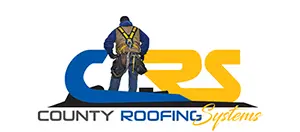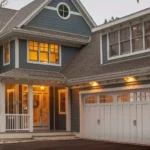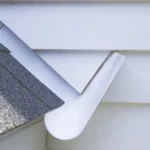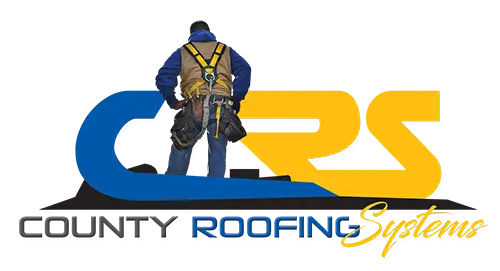What's the Difference Between Fascias and Soffits?
LEARN MORE ABOUT ROOF TRIM

Fascia boards and soffit panels add aesthetic appeal to your home. They serve as a visual indicator marking the boundaries between your roof and your exterior walls. But they also play an important role in protecting your house from rain and water damage.
Every day County Roofing Systems fixes exterior and roofing problems caused by an earlier contractor’s incompetence. The fascias and soffits are common failure points. Many contractors treat soffits and fascias like an afterthought.
We have several decades of experience with both roofing and siding installations. We know how important proper soffit and fascia installations are. We don’t cut corners on our work, because we know the damage that can result from carelessness.
Let’s take a closer look at why these seemingly decorative pieces are so important.
Why Are Soffits Important?
Soffits connect the edge of a roof to the underside of eaves. It gives your roof a finished look and keeps bugs and pests out of your attic. But they do more than just improve your home’s curb appeal. Most important of all, soffits provide your attic with proper ventilation.
Attic ventilation is crucial to the good health of your home. Air circulation helps keep warm air flowing out during summer days when the shingles are baking in the sun. It also keeps the humidity down in your attic space, which helps prevent mold and other issues. Ventilated soffits keep out vermin, but provide a space for airflow.
Signs You May Have Attic Ventilation Issues
- Your asphalt shingles are showing signs of heat damage
- Fungus or mildew growth on your attic walls
- Frequent leaks
- Curling, buckling, or missing shingles
In over 35 years of business, we’ve worked with financing agents in every borough and throughout Long Island. We can put you in touch with local lenders who are happy to help you finance your home improvement project. If you already have a financing agent, we’ll provide all the paperwork they need to make the whole process as smooth as possible.
What Are Soffits Made Of?
Building suppliers use several different soffit materials:
Wood
Wood is easy to paint, so it’s easy to match a wood soffit with your home colors. Installers use rot and moisture-resistant woods like cedar, redwood, fir, and pine. Wooden soffits are more flammable and less durable than our other options. They can also have issues with carpenter wasps and termites.
PVC
PVC is the most commonly used soffit material. It’s less expensive than wood per square foot. PVC is also lighter and more resistant to water leaks and rot.
We use PVC when installing soffit. It comes in many colors and lasts longer than the alternatives. It’s frequently used for trim purposes like corner posts.
Aluminum
Aluminum soffits are more expensive than PVC and offer less insulation than wood. But aluminum is lightweight, fire-resistant, water-resistant and easy to work with. You’ll often see aluminum soffits on roofs with unusual roofing designs. The biggest issue with aluminum soffits is that they can get bent, twisted, or dented easily.
Fiber Cement
Fiber cement soffits can be attractive, durable, and easily painted. But they are heavier and more expensive than PVC soffits and require more specialized installation skills.
You May Also Like
What is a Fascia?
The fascia is the portion of siding located directly above the soffit, in front of the roof overhang. It supports the roof, shingles, and gutters and helps direct water away from the home. Fascias are typically made with wood, PVC, or fiber cement.
Your fascia is aesthetically important because it faces outward on your home. You need a fascia that is both durable and attractive to make your home look its best. It is also important that you have your fascia installed by a professional contractor.
Roofing installers attach your shingle starter strips to the fascia. This helps protect your roof against wind and from water damage should an ice dam build up.
A badly installed fascia can send water pouring in between your interior and exterior walls during heavy rains. Left unnoticed, these leaks can lead to mold, water damage, mildew, and other problems.
Clogged gutters often lead to fascia board damage. Because the water can no longer flow to the downspout, it slops over the edge onto the fascia. Should the rainfall get heavy enough, it can force its way behind the board. Keeping your gutters clear is important, as a flooded fascia board can lead to costly damage.
Careless renovations can frequently lead to soffit or fascia issues. A builder might cover over soffit venting with badly placed roofing material. You might not know air circulation was blocked until you see attic frost on an exposed rafter or notice unusually high air conditioning bills.

Keith Schmied has been working hard in Long Island and NYC for over 35 years. One of Long Island’s best roofing, siding, and exteriors contractors, Keith can help you protect your home with affordable, energy efficient repairs and installations.
New siding protects the exterior of your home and provides insulation benefits you won’t get from your old siding.
Whatever the job, we only use premium building materials and we only work with our experienced team of construction specialists. Give us a call today and find out what we can do for you.




